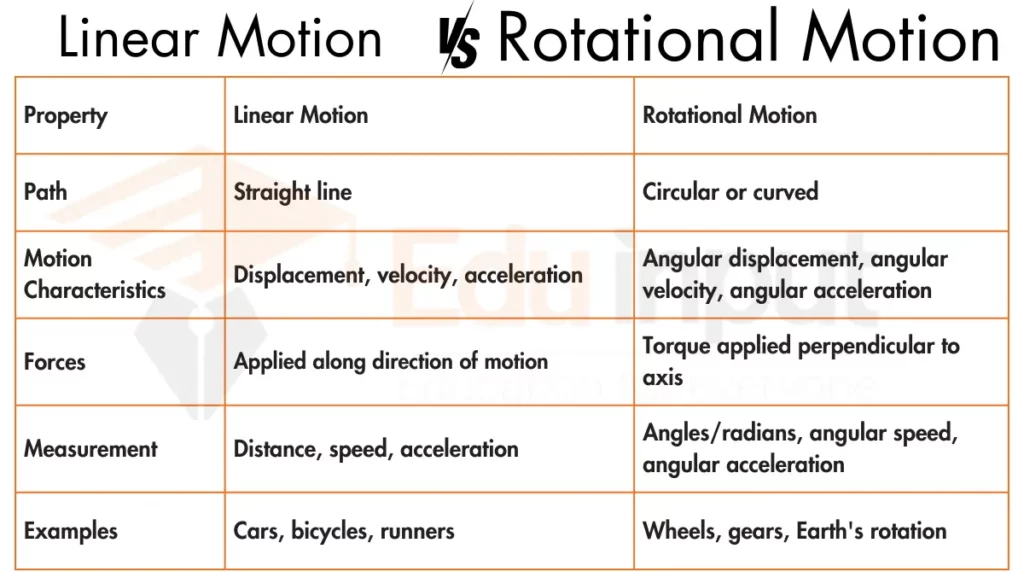Difference Between Linear Motion and Rotational Motion
The main difference between linear and rotational motion is the path of the object’s movement. Linear motion occurs along a straight line, while rotational motion follows a circular or curved path.
To make the concept of this topic you should also read my guide on examples of linear motion.

Comparative Analysis of Linear Motion and Rotational Motion
Here is a comparative analysis of linear motion vs circular motion:
1: Path
Linear motion involves movement in a straight line, while circular motion involves movement in a circular or curved path.
2: Motion Characteristics
Linear motion is characterized by displacement, velocity, and acceleration along the direction of motion. Circular motion is characterized by angular displacement, angular velocity, and angular acceleration with respect to a central axis.
3: Forces
Forces that cause linear motion act along the direction of motion. Torque, or rotational forces, act perpendicular to the axis of rotation in circular motion.
4: Measurement
Linear motion is quantified in terms of distance traveled, speed, and rate of change of speed (acceleration). Circular motion is quantified in terms of angles, angular velocity (radians/second), and angular acceleration (radians/second2).
5: Fluid Friction
Both linear and circular motion experience fluid friction when moving through fluids like air or water. This friction force opposes the motion.
6: Rotational vs Circular Motion
Not all circular motion is purely rotational. For example, a car taking a curved path undergoes circular but not rotational motion. All rotational motion involves spinning or revolving around an axis.
7: Real-World Applications
Both linear and circular motion principles are applied extensively in engineering, physics, sports, machine design across domains. Additionally, circular motion finds special applications in power generation turbines, robotics, and transportation.
8: Driving Innovation
Fundamental research and insights into both linear motion and circular motion drive innovation in transportation, energy generation from wind, hydro or steam turbines, robotics, and sports equipment design.
9: Examples
Common examples of linear motion are cars, bicycles, and runners moving in a straight line. Circular motion is seen in wheels, gears, Earth’s rotation, and revolution.
Linear Motion vs Rotational Motion
| Property | Linear Motion | Rotational Motion |
|---|---|---|
| Path | Straight line | Circular or curved |
| Motion Characteristics | Displacement, velocity, acceleration | Angular displacement, angular velocity, angular acceleration |
| Forces | Applied along direction of motion | Torque applied perpendicular to axis |
| Measurement | Distance, speed, acceleration | Angles/radians, angular speed, angular acceleration |
| Examples | Cars, bicycles, runners | Wheels, gears, Earth’s rotation |
| Fluid Friction | Can be experienced when moving through fluids | Can be experienced when moving through fluids |
| Rotational vs. Circular Motion | Not all circular motion is purely rotational (e.g., car on a curve) | All rotational motion involves spinning/revolving |
| Real-World Applications | Engineering, physics, sports, machine design, etc. | Engineering, physics, energy generation, robotics, etc. |
| Driving Innovation | Transportation (vehicles, turbines), energy generation (wind, hydro, steam), robotics, sports equipment design, etc. | Transportation (vehicles, turbines), energy generation (wind, hydro, steam), robotics, sports equipment design, etc. |

 written by
written by 





Leave a Reply